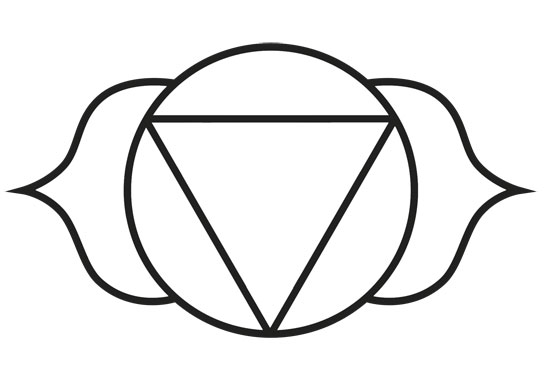Ajna is a traditionally Hindu symbol that represents the third-eye Chakra, or the part of the brain that is said to reveal details about the future. The Hindus believe that spiritual energy from the environment enters them through Ajna, which is why they use vermilion, Namam, holy ash, and similar substances to mark their foreheads. In Buddhism, Ajna is called the Eye of Consciousness, which calls upon followers to view the world beyond what their physical eyes can see. In other words, see the world with their minds.
This symbol is mostly transparent, with two white petals and a pericarp containing the Shakti Hakini. The latter is illustrated with six faces, six arms, a white moon, a rosary, and a drum. The arms are in a position that depicts the granting of favors and elimination of fears. Above her head is a downward triangle containing a white lingam. Another, smaller triangle containing the Om and the Bija mantra hovers above it.

One theory states that Ajna, which also translates as ‘command’, is associated with insights and intuition. This belief stems from the fact that its chakra is positioned over the eyes, affecting perception. Because human cultures tend to be visual in scope, the ability to correctly perceive (‘see’) oneself is the key to manifesting the life each person is meant to live.

Symbols Menu:
» Amulet
» Ajna
» Arsenic
» Merkaba
» Hung
» Yin Yang
» bindi
» IK Onkar
» Khanda
» Halo
» jiahu
» Tau
» Uraeus
» Menorah
» Quincunx
» Tilaka
» Taijitu
» Vajra
» Chai
» Chi Rho
» Bagua
» Dragon
» Hunab Ku
» Caduceus
» Infinity
» Ichthus
» Hedjet
» Lauburu
» Om
» Ankh
» Chalice
» Pentacle
» Maat
» Ogham
» Mandala
» Kartika
» Khamsa
» Heart
» Labrys
» Sun Face
» Raven
» Triskele
» Scarab
» Dove
» Hanukia
» Anubis
» Trishula
» Durga
» Mezuzah
» Bay Tree
» Geruda
» Kinnara
» Quito
» Condor
» Blue Jay
» Falcon
» Makara
» Rosary
» Uluru
» Apsaras
» Hanuman
» Serpent
» Minotaur
» Mercury
» Apex
» Vestra
» Yoni
» Astarte
» dakini
» Calabash
» Mandrake
» Rebis
» Typhon
» Vegvísir
